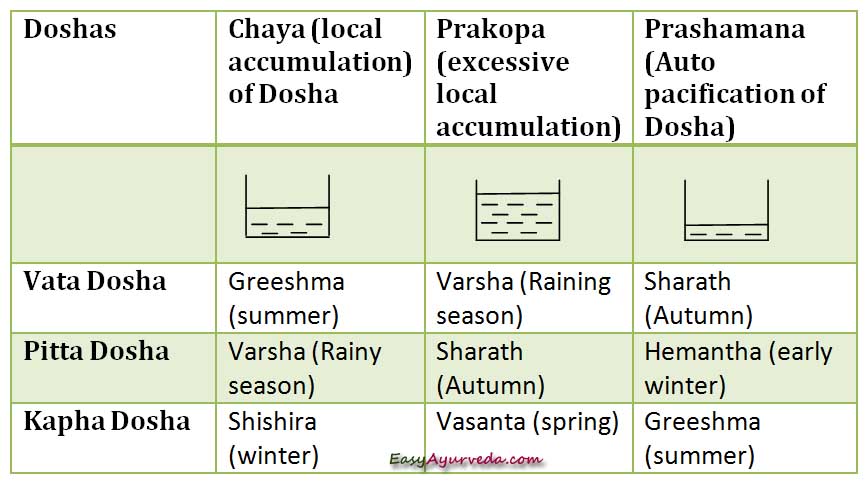Article by Dr Raghuram Y.S. MD (Ay) & Dr Manasa, B.A.M.S
Table of Contents
Introduction
Dosha Gati means movement or status of Doshas. Movement of Doshas from their places to others causes diseases. It is also a form of Dosha vitation which is the prime contributory factor for causation of diseases.
There are many types of dosha movements. Here, in this context we would be discussing about the dosha movements which occur due to the impact of seasonal changes i.e. chaya, prakopa and prashama of doshas.
Related reading – Types of Dosha Dushti – Dosha vitiation
Chaya, Prakopa, Prashamana of Doshas
Chaya (Sanchaya) means accumulation of doshas in their own seats
Prakopa (Kopa) means aggravation of doshas in their own seats and
Prashamana (Shamana) means auto-pacification of doshas.
Chaya, Prakopa and Prashamana are considered as dosha movements occurring in different seasons due to weather changes. This is also called as Rtu Kriya Kala or Dosha Kriya Kala
Related reading – Role of Doshas In the Causation of Disease
In the stage of accumulation of Dosha (chaya or sanchaya stage), the doshas tend to accumulate in their chief seats.
In the following season the dosha accumulation further progresses and the dosha gets aggravated in its own seat (prakopa).
Read related: Dosha Gati: Normal And Abnormal Movements Of Doshas
If the Rtucharya i.e. seasonal regimen is followed correctly, the doshas pacify by themselves in the upcoming season (shamana) and do not progress to the next stages of disease manifestation and hence, they do not cause diseases.
On the other hand, if the Rtucharya is not followed correctly, the doshas instead of undergoing auto-pacification will progress through the next stages of pathogenesis –
i.e. Prasara (stage of spread of doshas in all parts of body),
Sthana Samshraya (localization of vitiated doshas in tissues leading to their damage and production of purvarupas or premonitory symptoms of disease),
Vyakta (manifestation of disease and its signs and symptoms) and
Bheda (stage of complications).

Example
Example, Kapha sanchaya takes place in Shishira Rtu or late winter.
Kapha gets accumulated in its own place in later winter.
In the following season i.e. spring season, kapha prakopa (excessive acumulates excessively in its own place).
If seasonal regimen are followed in later winter and spring seasons, then Kapha gets pacified naturally in the next season – Grishma Rtu or summer season. So, Kapha unders pacification (Prashama) in summer season, naturally.
If Ritucharya is not followed, the kapha instead of getting pacified (prashamana) will progress to other stages of pathogenesis (samprapti or kriya kala) i.e. prasara (stage of spread), sthana samshraya (lodgment of dosha in dhatus or tissues), vyakta (manifestation of disease) and bheda (formation of complications).
This kapha, instead of undergoing auto-pacification will progress to form the diseases, mainly kaphaja diseases in future time.
For a better understanding of these gatis the topic of ‘Kriya Kala’ should give a better clarification.
Related Reading – Kriya Kalas – stage wise disease management
Importance
Importance of having the knowledge of Chaya, Kopa and Shamana of doshas
It is very important that a physician has a thorough knowledge of these gatis of the dosha. The knowledge of these gatis would help a physician to know the quality and quantity of vitiation of doshas and also the progression of the dosha vitiation and try to implement interventions as soon as possible. When the dosha vitiation is controlled at the earlier stages it doesn’t progress to the next stages of pathogenesis and hence the disease process is aborted at the earliest.
Example
What is Dosha Sanchaya and Dosha Prakopa?
Dr JV Hebbar
Sanchaya and Prakopa are two stages of Dosha increase. In the Sanchaya stage, the Dosha increases locally, in its own place. For example, the throat is a place for Kapha dosha. Eating an ice cream and drenching in rain causing an increase in kapha causing throat irritation. A milder treatment
Prakopa is the next stage of Dosha increase, wherein the dosha further aggravates and fills up the whole of its place.
For example, eating a lot of ice cream, drenching in rain and drinking contaminated food causes kapha aggravation leading to cold, cough and throat irritation.
From a treatment standpoint:
It is easy to treat Doshas in their first Sanchaya stage of aggravation. Sore throat? Ginger juice with honey would help to calm down the Kapha Sanchaya.
It takes some more effort to treat the Doshas in the Prakopa stage, as it is a higher level of aggravation.
In the given example, Talisadi churna with Kantakari Avaleha might be required.
Read: Sore Throat Causes, Ayurveda Remedies, Treatment, Therapies










